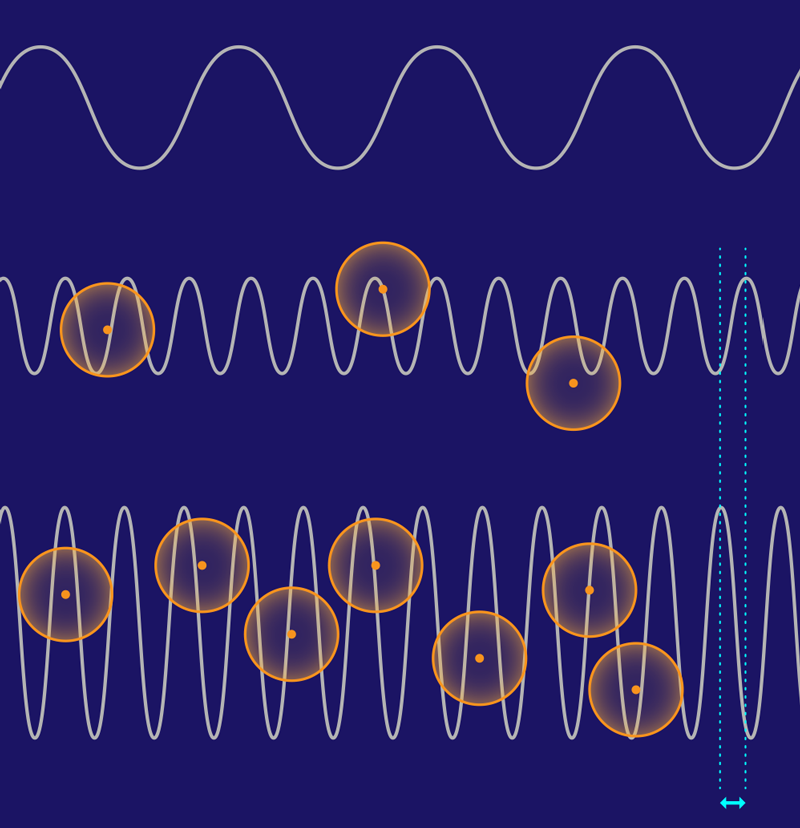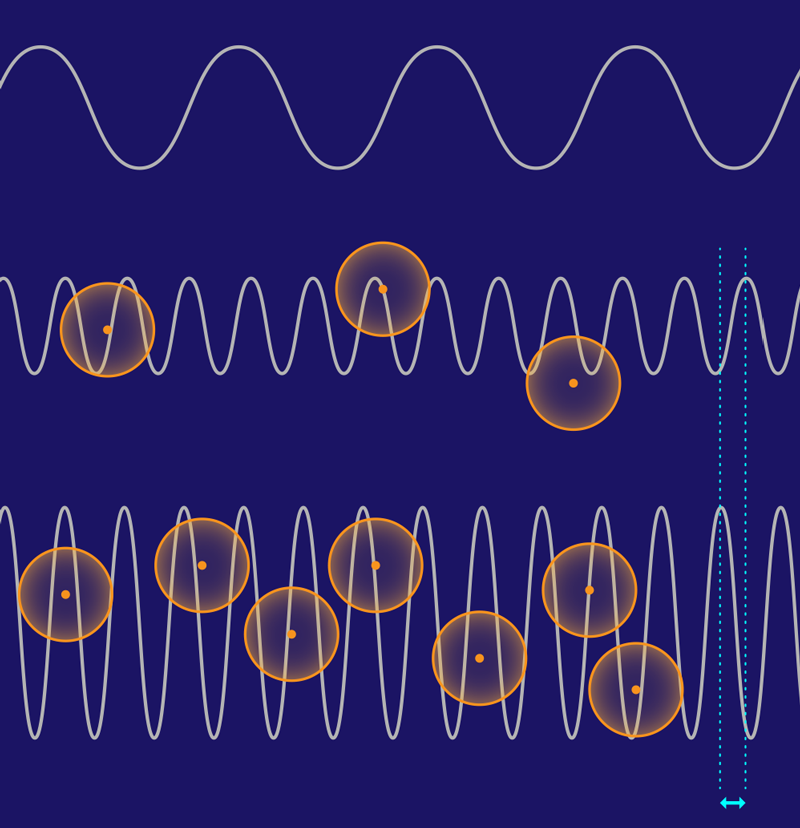A Solid Observation of Strong Kerr Nonlinearity
Among the benefits brought about by the invention of the laser in the 1960s is the ability to generate light at an intensity great enough to produce nonlinear optical effects. Such nonlinear effects have entered daily use in applications that include infrared-to-visible-light wavelength conversion (in a green laser pointer, for example) and two-photon excitation (in fluorescence microscopes for observing biological living tissue). Now Corentin Morin of the École Normale Supérieure in Paris and colleagues address a third-order nonlinear process called the Kerr effect, which manifests as a change in a material’s refractive index when it is illuminated with light of different intensities [1]. The researchers demonstrate a giant Kerr nonlinearity in a solid, a state of matter that has, until now, exhibited only a weak Kerr effect. The result implies the possibility of scalable nonlinear quantum optics without the need of cold atoms in high vacuum.
The key to the discovery by Morin and colleagues is a quasiparticle called a Rydberg exciton, the understanding of which rests on two concepts. The first concept is the Rydberg series, which is the discrete energy-level structure available to an atom’s outermost electron, and which is indexed by the principal quantum number n. A high-lying Rydberg state has a large n and exhibits properties such as a large electron orbital radius, a long lifetime, and a large dipole moment, all of which are missing in the ground state. The second concept is a hydrogen-atom-like quasiparticle called an exciton—a negatively charged electron, photoexcited across a semiconductor’s band gap, Coulomb-bound to a positively charged hole left in the valence band. Like atoms, excitons can be excited into Rydberg states by absorbing photons, and, like high-lying atomic Rydberg states, the key properties of high-lying exciton Rydberg states include a long-range dipole interaction that leads to the Rydberg blockade effect. This blockade effect precludes the excitation of nearby Rydberg excitons, assuring a single quantum state within the blockade radius (on the order of a micrometer). Rydberg excitons are therefore good candidates for quantum bits in all-optical quantum information processing applications.
The critical difference between a Rydberg atom in a gas and a Rydberg exciton in a solid is the environment. Rydberg atoms are typically kept in a high vacuum, while Rydberg excitons are hosted in a semiconductor crystal lattice, where interactions with lattice vibrations and impurities are inevitable. These interactions can cause the exciton to dissipate energy, while radiative recombination (the return of the electron back to the valence band) can cause the exciton to be annihilated altogether. As a result, high-lying (high-n) Rydberg states are not well defined in semiconductors, the only exception being copper oxide (Cu2O), the first semiconductor in which Rydberg excitons were observed. Cu2O is unusually conducive to excitons because it has a unique band structure that forbids the rapid radiative recombination of electrons and holes. The identification of giant Rydberg excitons in this material [2, 3] has prompted many theoretical and experimental investigations [4].
The generation of Rydberg excitons in a semiconductor is the mechanism that underlies the Kerr nonlinearity. The presence of Rydberg excitons changes the material’s refractive index, and the more intense the incident light, the greater the density of excitons. The exciton density also increases when the wavelength of the incident light closely matches the energy required to excite a Rydberg exciton to a given n, with shorter wavelengths generating higher-lying Rydberg states with larger blockade radii.
To investigate the Kerr effect in a solid, Morin and colleagues performed an experiment that uses interferometric phase front imaging [5]. A light wave propagating through a high-refractive-index medium (in this case, Cu2O) is slowed compared to light in a vacuum and acquires a phase shift relative to the incident light wave (Fig. 1). Variations in this phase shift arising from any spatial heterogeneity of the light intensity are imprinted on the interference fringes that occur when the light beam passing through the Cu2O is combined with an equivalent light beam propagating through air. As a result, the light beam both induces and probes the Kerr effect simultaneously: using an incident beam with a Gaussian intensity profile, the researchers determined from a single measurement the intensity dependence of the phase shift and, therefore, the nonlinear optical index, which characterizes the size of the Kerr effect.
The researchers observed negative and positive phase shifts as large as ±0.25 radians across several Rydberg states of different n. A phase shift of this magnitude corresponds to a gigantic nonlinear optical index compared to previous maximum values seen in solids and approaches the maximum found for cold atoms [6]. An interesting discovery is that the phase shift—which should, according to conventional theory, increase proportionally to the incident light intensity—saturated above a certain threshold intensity. This threshold intensity decreased rapidly with increasing n, inversely following the n7 scaling law for the Rydberg blockade volume [7].
Traditionally, the Kerr effect has been used to implement optical switches in ultrafast spectroscopy and for self-focusing in ultrafast lasers, applications that can be described purely in terms of classical electromagnetism. However, the strong Kerr nonlinearity and saturation that Morin and colleagues have demonstrated using Rydberg excitons marks a step toward pushing the scheme of light-matter interactions into the quantum regime. Furthermore, because Rydberg excitons can comprise electrons and holes from multiple electronic bands, they possess a rich energy-level structure [8]. Using the intraseries and interseries transitions afforded by such a structure provides an exciting new degree of freedom for applications in nonlinear quantum optics, where multiple energy-level separations and excitation lifetimes are necessary [9, 10]. This complexity is in stark contrast with Rydberg states in atomic gases, whose energy structure is more or less similar among various atomic species.
Exploiting Rydberg states in solids should also come with practical advantages. Although the technology that allows Rydberg atoms to be trapped in optical lattices has been progressing rapidly, this platform still presents significant challenges. As transition frequencies are typically in the infrared part of the spectrum, researchers are hindered by the need to protect systems from black-body radiation, for example. It has also been difficult to integrate the high-vacuum systems required by magneto-optical traps with the refrigeration systems necessary to implement superconducting quantum-bit circuits. The demonstration of the Rydberg blockade in a semiconductor paves a way to explore Rydberg physics using systems that are scalable and convenient for constructing devices in the future.
References
- C. Morin et al., “Self-Kerr effect across the yellow Rydberg series of excitons in Cu2O,” Phys. Rev. Lett. 129, 137401 (2022).
- T. Kazimierczuk et al., “Giant Rydberg excitons in the copper oxide Cu2O,” Nature 514, 343 (2014).
- M. A. M. Versteegh et al., “Giant Rydberg excitons in Cu2O probed by photoluminescence excitation spectroscopy,” Phys. Rev. B 104, 245206 (2021).
- M. Aßmann and M. Bayer, “Semiconductor Rydberg physics,” Adv Quantum Tech 3, 1900134 (2020).
- E. Hecht, Optics (Pearson, Boston, 2017)[Amazon][WorldCat].
- L. V. Hau et al., “Light speed reduction to 17 metres per second in an ultracold atomic gas,” Nature 397, 594 (1999).
- J. Heckötter et al., “Asymmetric Rydberg blockade of giant excitons in cuprous oxide,” Nat Commun 12, 3556 (2021).
- M. Takahata and N. Naka, “Photoluminescence properties of the entire excitonic series in Cu2O,” Phys. Rev. B 98, 195205 (2018).
- L. A. P. Gallagher et al., “Microwave-optical coupling via Rydberg excitons in cuprous oxide,” Phys. Rev. Res. 4, 013031 (2022).
- P. Rommel et al., “Interseries dipole transitions from yellow to green excitons in cuprous oxide,” Phys. Rev. B 104, 085204 (2021).





